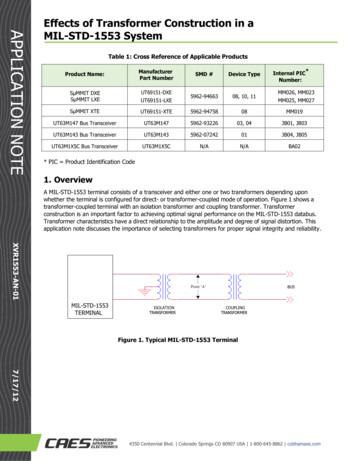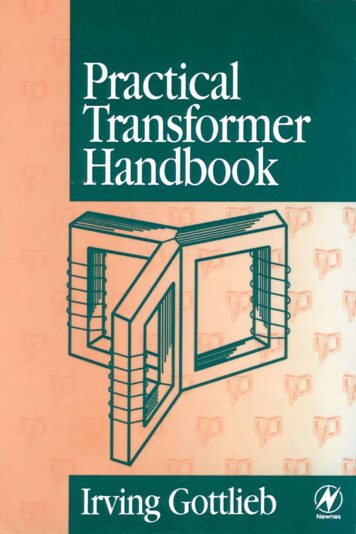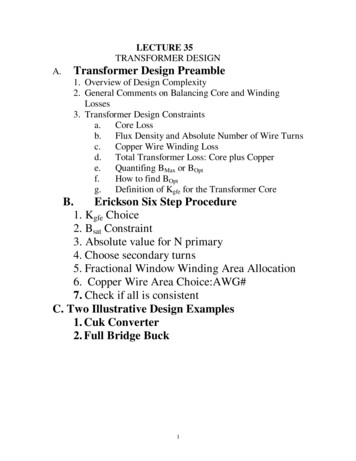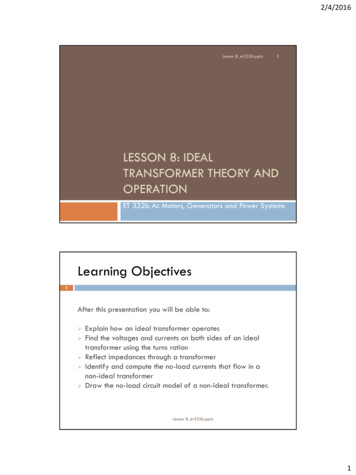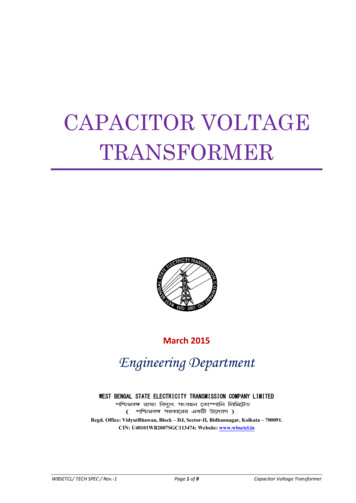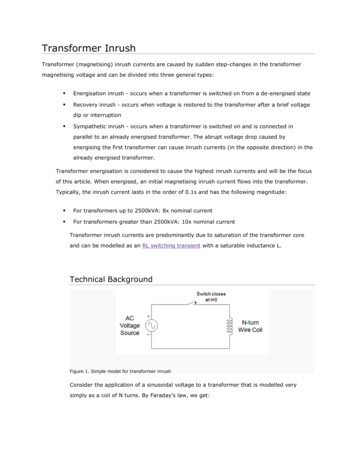
Transcription
Autumn 2014TheSupporting and Celebrating the Facilitators of AVP WorkshopsWhat’s new in theAVP Community ?In This IssueIntroducing New AVP/USAPresident: Dawn Addy . 1Unlock the Secret ofthe “CofC” . 2You can take part in the nextAVP/USA 2015 Conference . 2Increase in CommunityWorkshops in USA?. 3Are you offering workshopswith a different group than theusual Quakers?. 5AVP Community inside . 6Supererogation . 6Keeping your local groupvital. 7News from the AVPInternational Gathering inIreland . 9Our combined purpose . 9Order Form .11Introducing OUR NEW AVP PRESIDENT,DAWN E. ADDYWhen we think about AVPAVP-International gatherings to developUSA, prison work is usuallya higher education network to share bestthe first thought. But prisonpractices using AVP in research andwork is just one aspect of AVP as anteaching. The group can mentor youngorganization. My journey withAVP began in Spring of 1997with an invitation from EduardoDiaz (Espresso Eduardo) to joina weekend workshop in prison.Eduardo and I had met in a dialoguegroup I was facilitating in thecommunity. That was 17 years ago,and I’m still going into prisons on aregular basis, mainly to two facilitieswhere a high proportion of inmateshave completed at least a basicworkshop.I direct the Center for LaborResearch and Studies at FloridaInternational University (FIU) inAVP-USA new President Dawn AddyMiami. I incorporate AVP techniquesand principles into my curricula,professionals in related fields.especially for courses in ConflictIn my new role as President, I’m askingResolution and Consensus Building.the Committee of Committees to helpI bring student interns into prisons aslocal groups develop fiscally sustainableparticipants. The students come frommodels so they are not so reliant on justmany disciplines: psychology, socialone or two individuals. AVP workshopswork, adult education, criminal justice,affect both individuals and groups.women’s studies and sociology. TheSince community is a lived experience,students use their experience with AVPit is our mission to transform bothto transform professional developmentlives and groups in the community. Ipractices.hope you will join me in Seattle at theOne former student is the RegionalNational AVP Gathering, May 23-26,Director of Parole for South Florida;2015, to celebrate our accomplishmentsanother developed a program with atover the last 40 years and becomerisk kids called ESTOPP (Eradicatingenergized to move our organizationthe School to Prison Pipeline); anotherforward.is assessing South Florida AVPprograms for her doctoral dissertation.She obtained a grant to start a Panthersfor Peace club at FIU. I am promotinga conversation at both AVP-USA and
The TransformerAutumn 2014Unlock The Secret Of “C Of C”The Transformer is a quarterlypublication of the Alternativesto Violence Project of theUnited States of America.Headquarters and DistributionService, Subscription:1050 Selby AvenueSt. Paul, MN 55104Phone: (888) 278-7820E-mail: info@avpusa.orgWebsite: www.avpusa.orgPlease make checks payableto AVP/USA.Editorial Coordinators: Pat Hardyand Ed SabinCopy Editor: Joan CowanEditorial copy for the newsletterand requests for “Guidelines forSubmission” should be e-mailedto editor@avpusa.org. If noInternet capability, mail toThe TransformerP.O. Box 3294Santa Barbara, CA 93105Phone: (805) 886-9773Graphic Design: Four Winds GraphicsQuestions and address changes:Contact: transformer@avpusa.orgOr go to: www.avpusa.orgSubscription Rates:Green Electronic Edition . 10Paper Edition:Prisoners and Parolees. 5/yearAll others:1 year . 16.502 years. 27.503 years . 38.50Share-A-Transformer Deal . 20You copy/email & distribute to your group.Send AVPUSA their contact info.Group rate(5 or more subs at the same time)Green Electronic Edition . 5 eaPaper Edition. 11 eaFirst year as new facilitator is free(submitted by local coordinator).Back issues may be found atwww.thetransformer.usC of Cstands for AVP’s Committee of Committees. It is, essentially,the Board of Directors of AVP-USA. It is composed of thechairs of various AVP national committees plus our elected officers. Committee ofCommittee members are busy people doing local programs just like the rest of us.Can you imagine presenting a great idea you have for non-violence trainingwithout the experience of a national organization behind you? Do you appreciatelearning new exercises? Do you take for granted the availability of updated manualsto purchase? Have you ever learned something important or shared something at anAnnual National Gathering?Have you ever dealt with a prison administrator or community leader who wantsto shorten a workshop or require participation in it? If so, you had the standardsof a national organization to back you up. Have you ever received a scholarshipto attend a National Gathering? Do you use the AVP/USA.org website? Have youever referred someone to the site or directed someone to the research papers there?All this is done by volunteers just like you—but we need help! When you seea “help wanted” call from an AVP national committee, please respond. We have avery part-time employee, Thomas Boyd, working on fund raising. He needs yourhelp also. Remember, we work using the internet mostly, so your time and talentcan be used wherever you live!Conference Committee For 2015We are a “grass roots” organization-that means you have a lot ofinfluence on what you would like tohave happen at our Annual Gatheringon Memorial Day Weekend, May 22-25,2015, near Seattle, Washington.We will be celebrating our 40thAnniversary at this Conference andwelcome your suggestions for speakers,programs and breakout sessions.What do we want to celebrate? Whatdo we need to learn? What do weneed to do next? Now is the time tomake suggestions. Contact the LocalCommittee (rick@krouscop.net) orNancy of the National ConferenceCommittee (nhutchins471@comcast.com).We also would like to hear from oneor two people who would serve on thescholarship committee for this year’sconference, particularly if you havebeen the recipient of a previous award.Registration and program details willbe available at www.avpconference.orgin January.This newsletter is printedon recycled paper.2 A Publication of AVP/USA
The TransformerAutumn 2014Increase in Community Workshops in USA?The very well compiled 2013 CLARG(Committee of Local and Regional Groups)Report shows some interesting trends ingrowth of community workshops.Basic workshops increaseThis annual report of AVP-USA reflects a dramaticincrease in the Basic Workshops offered inthe community. In 2007, we did not ask aboutcommunity workshops; however, in 2008, 81workshops took place with 996 participants. In2013, well over double that number of Basics werereported(108) with 1,241 participants.Second Level and Facilitator training flatAdvanced and Training for Facilitators Workshopsshowed a drop by half during 2010 and 2011 andthen recovery in 2012 and 2013, but no real increase.This is reflected statistically by 34 Advanced and22 T4Fs in 2008; returning in 2013 to 36 and 27workshops respectively.Youth workshops inconsistentFirst recording of youth workshops in this reportstarted in 2009, with 37 Basic Workshops and 173participants. These dropped during the next 3 yearsto 12, 12 and 5 workshops and jumped to 48 in2013.Advanced Workshops for youth showed a leap inparticipants from 173 in 2009 to 844 in 2013, withan equally dramatic drop for one year (2012) to 16graduates.No T4Fs were recorded until 2010, but all have beenin the single digits since reporting began and are allover the map in terms of graduates from 56 in 2010to 40, 37 and 4 in the next 3 years.Trends by regionsThe states with the larger prison programs, NewYork and California, continue to steadily increasetheir community workshops. New York offered 23community workshops with 189 participants, plus6 workshops for 89 youth. California offered 44workshops in communities with 9 Basic Workshops(specifically for 173 youth), with a total of 717California community graduates. These 2 statestrained 995 people in community workshops (37%of the national total). All other states offered anincrease from the past by 1 or 2 workshops a year.Locations of workshopsWhere workshops are located in the communityoften reflects the variety of audiences that AVP isreaching. Many groups are still depending on theinitial roots of AVP, Quaker Meetings, to provideattendees and/or a site for the workshops.AVP groups reaching deeper into the local cultureare meeting at the following places: Community Centers Calvary, Presbyterian, Lutheran, Unitarian andEpiscopal Churches Song Common House, Eco-Village, Ithaca, NY Women’s Info Center, Syracuse, NY Inter-Cultural Women’s Center,Anthony, NM Gandhi Institute, Rochester, NY Interfaith Center at the University of Rochester,Rochester, NY Family Partnership Center, Poughkeepsie, NY Colleges and universities, including: VassarCollege, Haverford College, Arcadia University,University of Nebraska World Peace Sanctuary, Wassaic, NY Sister Karen Klimczak Center for Nonviolence,Buffalo, NY The Center for Returning Citizens,Philadelphia, PA Charter High and Middle Schools New Jerusalem Recovery Community,Philadelphia, PA Friends General Conference at the University ofNorth Colorado Palestine and IsraelNew developmentsIllinois and Minnesota facilitators combined toresurrect AVP-Chicago inner-city workshops wherea group is not meeting regularly and seeking ways tooffer community workshops.Nebraska showed the largest community growthin the Midwest regions. In Lincoln, they find itamazing to realize they are giving more workshopsin the community than inside the regular prisons.One reason for this is the availability of men andwomen from the Community Corrections Center,also made possible by facilitators who have trainedat the other prisons as well as new facilitators andparticipants. Others come from the County DrugContinued on page 4A Publication of AVP/USA3
Autumn 2014The TransformerContinued from page 3Increase in Community.Court and People’s City Mission. Mississippi facilitatorJim Henderson was asked to present some of the AVPmaterials at Grace House (http://www.gracehousems.org).Though not a correctional institution, Grace House hadexperienced some incidents of violence resulting from thesame sources of violence that prisoners have experienced;some residents of Grace House have been incarcerated. InJanuary, weekly hour-long sessions with the residents ofGrace House began.New Mexico’s Crossing Borders AVP reports small butimportant and familiar joys:1) We exist and made it through our first year.2) We have connected with facilitators in Arizona andhave found an experienced facilitator who hasmoved into our area.3) People from our Basics are interested in continuingwith AVP.Familiar challenges other AVP groups are facing:1) We are starting up in a widespread area (El Paso toTucson and north to Silver City).2) Many of those interested are overworked and havebusy lives.3) Incorporating and training Spanish-speakingfacilitators4) How to do the IRS reportThis year California volunteers, who not only get thingsgoing but keep them going in their local groups, havestepped up and are taking AVP guides and methods intotheir council meetings. After a workshop on “circledialogues” at the statewide Fall Gathering, a follow-upexperiential workshop was offered to a council wrestlingwith its direction and leadership. We look towards makingour “business” meetings extensions of our workshopmethods, which we hope will increase the effectivenessand longevity of our local groups.Keeping returning citizens involvedA dream in California is for all community workshopsto be run by those who were formerly incarcerated.Maintaining relationships with former inmates duringthat rocky re-entry period has involved a long learningcurve for those working in the community. Once someonecalls their 800 number, keeping in contact with theseindividuals is an ongoing challenge; but they are makingprogress.Answers that would be valuable in future CLARGreportsThough the question of the number of community peopletrained in prison is not asked in this report, anecdotalinformation shows that these community-trained numbersare actually greater because we know communitymembers often are brought into prisons to be trainedwhen a community workshop either is not available or iscancelled due to lack of participants.The other question that would be interesting is: how manyyouth are trained in community workshops that are notspecifically called youth workshops? Experience showsthere is definitely an overlap of youth in adult and adult inyouth workshops.We need to be cautious and selective in asking morequestions, which may not help AVP-USA understand theneeds of community groups.Thank youThe fact that so many local groups keep such detailedtracking of these numbers is impressive for an allvolunteer organization--or any organization for thatmatter. Special thanks to Valentine Doyle for compilingthe 2013 CLARG Report.The individuals who offer community workshopsare amazing in their stick-to-itiveness and creativityafter having to cancel workshops or put on very smallworkshops. And yet they figure out a way to make it workbetter the next time.The summary was compiled by Pat Hardy. For a copy ofthe full report, go to www.avpusa.org; on the left side,click on “For our current work, see our Annual WorkshopReport.”The introduction of a national Community Interest Committee monthly conference call has beena good source of ideas for finding community workshop attendees and getting ideas on handlingchallenges specific to community work. Steve Gelb in San Diego is the new coordinator of thisvaluable resource. The group also has a forum to which members can contribute. To subscribe,email community subscribe@avpusa.org.4 A Publication of AVP/USA
The TransformerAutumn 2014From the AVP-USA Facilitator Group:Are you offering workshops with a different group than the usualQuakers?We asked: What are you doing in yourcommunity--especially ways you areinvolving Returning Citizens? Withthe announcement by FCNL (FriendsCommittee on National Legislation) ofthe White House’s awarding HomeboyIndustries as one of the Championsof Change in the area of Reentry, Irealized that around the U.S. we aredoing some different and amazingthings in the community. For example,AVP-Los Angeles is offering regularworkshops and minis at HomeboyIndustries.So tell us what you are doing.AVP-Santa Barbara, California, isworking with at-risk youth and gangintervention street workers who areformerly incarcerated citizens. In bimonthly workshops with Juvenile Hallyouth who are on Probation, communitypeople are invited to participate, givingus a workshop location for adultswhen we cannot get a completely fullworkshop.Present Pat Hardy /Lovable Lizzie RodriguezLincoln, Nebraska and ReturningCitizensFor the past year or so in Lincoln,NE, we have been offering regular(meaning nearly monthly) workshopsin the community. At least one personon every team has been someone whostarted AVP while they were in prison.Many come from the Work ReleaseCenter. Several are on parole--some,completely free. It has been wonderful!Mama MargeAVP Community Workshops inSpringfield, MassachusettsAVP-Springfield has a new site for ourAVP Community workshops. Theywill be held at the Springfield HousingAuthority’s new offices at 60 CongressSt., Springfield, MA, thanks tofacilitator/coordinator, Michelle BoothA Publication of AVP/USAof the Springfield Housing Authority.This year, five AVP facilitators havestepped up to form the AVP SpringfieldArea Council. They will be attendingluncheons and events for the purposeof seeking volunteers and are workingtogether to organize workshops in eachof four areas: community workshopsin English, in Spanish, in Springfieldpublic schools and at the Ludlow PreRelease Center.Four one-day trainings (one permonth) occurred over the summer atthe AVP community workshop site onCongress Street. The goal was to bringSpringfield leadership up to date withthe organization, connect them to AVPUSA and AVP-MA and work throughthe agendas and various exercises.Karing Kathy Rubenstein,Springfield Coordinator,kathymrubenstein@gmail.comfinancial diversity, 30-year-olds andoccupationally diverse. This is slowgoing--it’s still mostly older, white,long- termers and Quakers.The Community Interest Committeeconference call is held the secondWednesday of the month at 5:30pmPacific time and 8:30pm Eastern time.To be a part of this Google groupto share more ideas, subscribe atcommunity subscribe@avpusa.org; conference call number is 641-7153300; access code is 988935#.Join others to share successes andchallenges once a month or duringthe month.Ideas from the monthlyCommunity Interest Committeeconference call:After great reviews of the AVP-USAOrganizing Kit, this group discussedwhat needs to be in the next publicationaround community workshoprecruitment:Find an established group as the coregroup of attendees; then add randompeople from the community. Presently,others are involved with these groups:Juvenile Hall, Community Alliancesof service providers, center fornonviolence, homeless center for theirstaff, multi-group organizations andinterfaith coalition.Consciously recruiting for diversity(in education, gender, age, socioeconomic, gang-related, homeless )helps to increase the quality of theworkshop. The more barriers you breakdown, the more amazing the interaction.Is council diverse as a result of thisdiversity in workshop participants?To some extent, but not as much aswe would like. Now, we have a fewreturned citizens, people with5
The TransformerAutumn 2014AVP Communityby Generous Jason Guinnt the end of each workshop whenwe get to the question: “Wheredo we go from here?”, I can feel thereluctance of the participants for theworkshop to end. When I feel that, Ialways say, “This workshop may nothave made us all best friends, but theexperience we shared will allow us toacknowledge each other with a smile, awave, a “good morning” because we arenow part of the AVP community. Thisfeeling we have does not have to endjust because the workshop is over.The different personalities, goals,ages and backgrounds all seem tofade when AVP is brought ontothe yard. Once I have had the AVPexperience and shared some intimateAparts of my life, it’s hard to go backand look at those people as being sodifferent from me. I know there arecommunity members willing to shareabout themselves and to listen toand help with anything I have to say.This is because of the AVP bond ofcompassion, respect and caring whichmost of us never knew when we hadto hustle the whole time. AllowingTransforming Power to work in my lifeis a beacon which draws others towardsAVP. At least once a day I overhearguys talking about AVP. Sometimes it’sjust, “Hey, what is AVP?” Other timesit’s someone sharing how AVP affectedthem or asking the question, “How do Isign up?”Being a community member remindsme I have tools to use when a conflictarises. It also reminds me I have theobligation to walk the AVP walk andtalk the AVP talk. AVP helps keep megrounded. When prison administrationssupport the program--as they do at(name of prison)--they deserve anAVP thank you! Inside and outsidefacilitators also deserve our thanks.Transforming Power blessing over theirlives.Reach for that which is good inothers. When you give your approvalwhile letting them know that you areproud of them, it is very affirming.Everyone needs to be valued andappreciated. Every person needs thatblessing. Build a community basedon honesty, respect and caring byplanting Transforming Power seedsin AVP groups and with co facilitatorsand friends in prison.Befriend someone no one talks to.Are you taking an interest to make thatperson’s life better? Are you listening totheir dreams without judgment? Reachfor that which is good in others whileencouraging them—that’s being an AVPpeople builder.If you talk with successful people,they’ll tell you someone believed inthem. Someone planted a seed andencouraged them when they didn’tbelieve in themselves. Someone helpedthem get a break. Someone told themto be willing to suffer for what isimportant.Sometimes we don’t realize thepower of Transforming Power--whatit means when someone tells a person,“I believe in you--be patient andpersistent; you’ve got what it takes.”Every facilitator can be someone else’snumber one fan by encouraging them,lifting them up when they fall andcelebrating when they succeed.I would like to extend my genuineappreciation to the facilitators ofthe Eastern Correctional Facility forwelcoming me back into the AVPfamily after so many years in theNorth Country wilderness whereAVP is desperately needed but not yetavailable. The men upstate are starvingfor AVP Transforming Power peoplebuilders.Generous Jason has been an inside AVPcoordinator in three prisons and helpedstart AVP in two of these. Currently heis in Calipatria State Prison, near ElCentro, CA.AVP SUPEREROGATIONby Smiling Steven Garofolohe Alternatives to ViolenceProject taught me the meaning ofsupererogation, going the extra mile,nearly four decades ago. I always shared itwhenever the opportunity presented itself.Everyone needs to be valued—everyoneneeds to be appreciated. Every personneeds that blessing.Transforming Power is the moralfiber that enables us to be peoplebuilders. Using Transforming Power,we seek opportunities to encourageothers, bring out the best in them andhelp them accomplish their dreams.Transforming Power helps us speakwords of respect, honesty and caring. Byaffirming others and letting them knowthey are valued, Transforming Power callsout the seeds of greatness and helps themrise higher.How many people have never been told,“You are important, special, smart ora winner”? There are people--possiblyin your AVP group right now--whomyou work or play ball with or even afamily member who are starving forapproval. They crave for you to speak theTSmiling Steve writes from withinEastern New York Correctional Facility,Napanoch, NY6 A Publication of AVP/USA
The TransformerAutumn 2014Excerpted rom the AVP USA Organizing Kit, Chapter 4: KEEPING YOUR LOCAL GROUP VITALA workshop is one weekend. The local group is real life.Local groups are the basic foundation of AVP nationally and internationally. Your local group’s health is maintainedprimarily by your facilitators’ commitment to working out the inevitable problems. Though experienced facilitatorsaround the country are happy to answer your questions, the real problem-solving decisions come from your fellow localfacilitators. Ideas for solutions to group stress can be found in the Basic, Advanced and Training for Facilitators Manuals andwithin you--not unlike life.SUGGESTIONS THAT MAY HELP OVER THE LONG HAUL AS YOU GROW: Have regular meetings of the AVP local group on whatever schedule works for your group. Face-to-face ispreferable, but conference calls can fill gaps. Check FreeConferenceCall.com. Try an annual party. If possible keep doing community workshops to build up and strengthen the base of outside facilitators andcommunity support.NUTS AND BOLTS Keep good financial records. Either designate a revolving Treasurer position or have your bookkeeping recordslooked at by more than one set of eyes. Take brief minutes of your meetings with decisions listed and distribute to all group members. Raise funds! Offer community workshops. Someone in your group may feel led to do wider fundraising;encourage them. Develop a lead facilitator process, including mentoring and lead facilitator committee meetings and possiblydevelop Advanced Facilitation Skills workshops. A body of work already is being done at a number of LocalCouncils; check the AVP/USA list serve on the web to get input. See Appendix 4: Developing lead facilitators. Keeping true to the AVP/USA Policy Statement in your workshops and your group meetings helps to maintain ahigher standard of ethical AVP behavior.Your best resource is AVP/USA, Inc. Subscribe to The Transformer for Facilitators. (This quarterly publication is free to all new facilitators for thefirst year after they graduate from the TforF.) Very low price after that. Order online at www.avpusa.org. Checkwww.TheTransformer.us for free helpful back issues. Send representatives to National Conferences. The next one is in Seattle, WA, May 25-27, 2015. Seed grants are available for new or struggling organizations that might want to build a supply box for a newinstitution, bring in facilitators and get help covering airfare, get non-profit status (501 c3), have facilitatortraining sessions. Participate on the AVP/USA list serve. (Go to www.avpusa.org, click on “AVP/USA” then “e-maillistserve”, passwords: member, texashug) Be sure to ask for any kind of help you need. Start with the CLARG (Committee of Local and Regional Groups,see www.avpusa.org site.) A great deal of experience and wisdom is in the larger circle of AVP; takeadvantage of this. No doubt someone has dealt with your issues before and is willing to share their experience orwisdom gained. Use the website for articles, talk with your regional representative (also found on the website),use the AVP/USA listserve and expect responses that are helpful. The website, with updated information, is probably the best source: www.avpusa.org; but other contactinformation is available also by calling the national AVP/USA, Inc. office at (888) 278-7820, toll-free, or (651)644-5851. One can also write to: AVP/USA, 1050 Selby Ave., St. Paul, MN 55104 or avp@avpusa.org Keep your local information up-to-date on the website. Local councils, even of two people, are also responsiblefor filling out workshop data on the website. This consists of logging in as “member” using the password“texashug” and filling in the information (about three minutes per workshop) in the bar marked “AVP/USA,workshop data and activity reports.”MAINTAINING A COMMUNITY COUNCIL(aka Local Group, Area Council)A local council may consist of yourself and your best friend; or you might be large enough to operate from a singleoffice with paid staff and coordinate programs in 15 prisons from a central location. In this chapter, we will assume you’vesuccessfully begun your AVP program and wish to maintain and possibly grow it in a healthy supportive way.Catalyst factorThe role of “leadership” in AVP is to bring people together to see where they want to go and who is prepared to makeA Publication of AVP/USA7
Autumn 2014The Transformerit happen. The concept of a “person in charge” out in front is not part of the AVP vocabulary. The term “coordinator”or “organizer” is more likely to fit the role of “leader.” A group takes ownership when they are led (coordinated) frombehind—learning how to do it themselves. Those “in charge” may fit best into AVP if they think of themselves as volunteercoordinators catalyzing others into discovering their best use.To understand more about the grass-roots approach of AVP—beyond AVP materials—read The Spider and the Starfish byBrafman and Beckstrom. A group will grow only as quickly as the individual members are willing to take on projects. Whenyou find people balking at taking on responsibilities for maintaining the group, take time to step back as a group and listen toone another. Listen for individual needs and challenges as they relate to the group’s needs and challenges, remembering theAVP Guides and Agreements from the Basic Manual as you work through these.(For familiar organizational structures in AVP, see Appendix 4: Examples of local groups.)When things get tough, step back and inside.One local group found itself increasingly faced with unresolved disagreements and enmitybetween one another. To try to resolve their unending conflict, they decided to stop facilitatingworkshops for a year during which they worked on themselves through a retreat, an AVPAdvanced Workshop just for them and regular social meetings, taking an opportunity to get toknow one another and redevelop trust and caring among them. That group still functions today,expanding and supporting workshops throughout the region. Deal with conflicts openly, using AVP guidelines. Talking behind one another’s backs and allowing issues to beunresolved create unnecessary problems for the group. Remain true to the AVP guidelines and the ideal of consensus decision-making. Support those who serve making policy and decisions, yet allow for reversal of decisions later if called for. Rotate the coordinators if at all possible to develop experience and reduce burnout. Vary the facilitators on yourteams so people work frequently with different people. The process of working with different teams is invigorating,sometimes challenging – a chance to develop one’s AVP skills and stimulate new ways of approaching the samebasic formats. Include your new facilitators in a workshop as early as possible after their TforF. If you have a schedule of up-coming events, each person in the TforF can sign up and know when they will have the opportunity to facilitate. Consider hosting the annual national gathering or a regional meeting. This can be very powerful in pullingyour local group together, increasing consciousness of the larger picture – not only in the United States but alsointernationally--and stimulating creativity and interest in doing more local and/or prison work.Don’t forget the inside facilitators A positive teaching and motivating dynamic flows back and forth with those who do communityworksho
started in 2009, with 37 Basic Workshops and 173 participants. These dropped during the next 3 years to 12, 12 and 5 workshops and jumped to 48 in 2013. Advanced Workshops for youth showed a leap in participants from 173 in 2009 to 844 in 2013, with an equally dramatic drop for one year (2012) to 16 graduates.




